Identifying Factors Reinforcing Robotization: Interactive Forces of Employment, Working Hour and Wage
Abstract
1. Introduction
2. Literature Review
3. Current Status of Robotization and the Labor Market in Korea
3.1. Industrial Robotization in Korea
3.2. The Labor Market of Korea
4. Empirical Analysis
4.1. Data and Analysis Method
4.2. Results
5. Discussion and Summary
Author Contributions
Conflicts of Interest
References
- International Federation of Robotics. World Robotics 2016-Industrial Robots; International Federation of Robotics Report; International Federation of Robotics: Frankfurt, Germany, 2016. [Google Scholar]
- World Economic Forum. The Future of Jobs: Employment, Skills and Workforce Strategy for the Fourth Industrial Revolution; World Economic Forum: Geneva, Switzerland, 2016. [Google Scholar]
- Frey, C.B.; Osborne, M. The future of employment: How susceptible are jobs to computerization? Technol. Forecast. Soc. Chang. 2017, 114, 254–280. [Google Scholar] [CrossRef]
- OECD iLibrary. OECD Employment and Labour Market Statistics. 2016. Available online: http://www.oecd-ilibrary.org/employment/data/oecd-employment-and-labour-market-statistics_lfs-dataen (accessed on 1 December 2017).
- McKinsey Global Institute. Job Lost, Jobs Gained: Workforce Transitions in a Time of Automation; McKinsey & Company: New York, NY, USA, 2017. [Google Scholar]
- Goos, M.; Manning, A.; Salomons, A. Explaining job polarization: Routine-biased technological change and offshoring. Am. Econ. Rev. 2014, 104, 2509–2526. [Google Scholar] [CrossRef]
- Arntz, M.; Gregory, T.; Zierahn, U. The Risk of Automation for Jobs in OECD Countries: A Comparative Analysis; OECD Social, Employment, and Migration Working Papers; OECD: Paris, France, 2016; Volume 189. [Google Scholar]
- Autor, D.H. Why are there still so many jobs? The history and future of workplace automation. J. Econ. Perspect. 2015, 29, 3–30. [Google Scholar] [CrossRef]
- Acemoglu, D.; Restrepo, P. The Race between Machine and Man: Implications of Technology for Growth, Factor Shares and Employment; National Bureau of Economic Research: Cambridge, MA, USA, 2016. [Google Scholar]
- Acemoglu, D. Labor and capital augmenting technical change. J. Eur. Econ. Assoc. 2003, 1, 1–37. [Google Scholar] [CrossRef]
- Pissarides, C.A. Equilibrium Unemployment Theory; MIT Press: Cambridge, MA, USA, 2000. [Google Scholar]
- McKinsey Global Institute. A Future that Works: Automation, Employment and Productivity; McKinsey & Company: New York, NY, USA, 2017. [Google Scholar]
- Brynjolfsson, E.; McAfee, A. Race against the Machine: How the Digital Revolution Is Accelerating Innovation, Driving Productivity, and Irreversibly Transforming Employment and the Economy; Digital Frontier Press: Lexington, MA, USA, 2011. [Google Scholar]
- Piva, M.; Vivarelli, M. Technological change and employment: Some micro evidence from Italy. Appl. Econ. Lett. 2004, 11, 373–376. [Google Scholar] [CrossRef]
- Autor, D.H.; Katz, L.F.; Krueger, A.B. Computing inequality: Have computers changed the labor market? Q. J. Econ. 1998, 113, 1169–1213. [Google Scholar] [CrossRef]
- Piva, M.; Vivarelli, M. The role of skills as a major driver of corporate R&D. Int. J. Manpow. 2009, 30, 835–852. [Google Scholar]
- International Federation of Robotics. Available online: https://ifr.org (accessed on 17 October 2017).
- International Federation of Robotics. World Robotics 2017-Industrial Robots; International Federation of Robotics Report; International Federation of Robotics: Frankfurt, Germany, 2017. [Google Scholar]
- Korea Occupational Safety and Health Agency. Work Environment Assessment Survey, 2014. Available online: https://www.kosha.or.kr/content.do?menuId=10260 (accessed on 17 October 2017).
- Statistics Korea. Economically Active Population Survey, August 2016. Available online: https://mdis.kostat.go.kr/index.do (accessed on 17 October 2017).
- Cho, J.; Lee, J. Persistence of the gender gap and low employment of female workers in a stratified labor market: Evidence from South Korea. Sustainability 2015, 7, 12425–12451. [Google Scholar] [CrossRef]
- Statistics Korea. Korean Standard Statistical Classification: Industrial Classification and Classification of Occupations, 2016. Available online: https://kssc.kostat.go.kr:8443/ksscNew_web/ekssc/main/main.do (accessed on 17 October 2017).
- Ministry of Employment and Labor. Survey on Labor Conditions by Employment Type, 2014. Available online: http://laborstat.moel.go.kr/ (accessed on 17 October 2017).
- Brynjolfsson, E.; McAfee, A. The Second Machine Age: Work, progress, and Prosperity in a Time of Brilliant Technologies; WW Norton & Company: New York, NY, USA, 2014. [Google Scholar]
- Ehrenberg, R.G.; Smith, R.S. Modern Labor Economics: Theory and Public Policy; Routledge: Abingdon, UK, 2016. [Google Scholar]
- White, M. Working Hours: Assessing the Potential for Reduction; JSTOR: New York, NY, USA, 1987. [Google Scholar]
- Sharma, G. Competing or collaborating siblings? In Industrial and Trade Policies in India; University of Missouri: Columbia, MO, USA, 2008. [Google Scholar]
- Woo, K.; Cho, J. Transferring the cost of wage rigidity to subcontracting firms: The case of Korea. Sustainability 2016, 8, 845. [Google Scholar] [CrossRef]
- Goldin, C.; Katz, L.F. The origins of technology-skill complementarity. Q. J. Econ. 1998, 113, 693–732. [Google Scholar] [CrossRef]
- Gray, R. Taking technology to task: The skill content of technological change in early twentieth century united states. Explor. Econ. Hist. 2013, 50, 351–367. [Google Scholar] [CrossRef]
- Lindbeck, A.; Snower, D.J. Wage setting, unemployment, and insider-outsider relations. Am. Econ. Rev. 1986, 76, 235–239. [Google Scholar]
- Solow, R.M. Insiders and outsiders in wage determination. In Trade Unions, Wage Formation and Macroeconomic Stability; Springer: Berlin, Germany, 1986; pp. 269–286. [Google Scholar]
- Bentolila, S.; Dolado, J.J. Labour flexibility and wages: Lessons from Spain. Econ. Policy 1994, 9, 53–99. [Google Scholar] [CrossRef]
- Devicienti, F.; Naticchioni, P.; Ricci, A. Temporary employment, demand volatility, and unions: Firm-level evidence. ILR Rev. 2015, 71, 174–207. [Google Scholar] [CrossRef]
- Saint-Paul, G. Dual Labor Markets: A Macroeconomic Perspective; MIT Press: Cambridge, MA, USA, 1996. [Google Scholar]
- Golden, L. The expansion of temporary help employment in the US, 1982–1992: A test of alternative economic explanations. Appl. Econ. 1996, 28, 1127–1141. [Google Scholar] [CrossRef]
- Smith, V. New forms of work organization. Ann. Rev. Sociol. 1997, 23, 315–339. [Google Scholar] [CrossRef]
- Acemoglu, D.; Autor, D. Skills, tasks and technologies: Implications for employment and earnings. In Handbook of Labor Economics; Elsevier: Amsterdam, The Netherlands, 2011; Volume 4, pp. 1043–1171. [Google Scholar]
- Lorentz, M.; Rüsmann, M.; Strack, R.; Lueth, K.; Bolle, M. Man and Machine in Industry 4.0: How Will Technology Transform the Industrial Workforce through 2025? The Boston Consulting Group: Boston, MA, USA, 2015. [Google Scholar]
- Chui, M.; Manyika, J.; Miremadi, M. Four fundamentals of workplace automation. McKinsey Q. 2015, 29, 1–9. [Google Scholar]
- Hamilton, L.C. Statistics with Stata: Version 12; Cengage Learning: Boston, MA, USA, 2012. [Google Scholar]
- Geishecker, I.; Görg, H. Winners and losers: A micro-level analysis of international outsourcing and wages. Can. J. Econ. 2008, 41, 243–270. [Google Scholar] [CrossRef]
- Lankford, W.M.; Parsa, F. Outsourcing: a primer. Manag. Decis. 1999, 37, 310–316. [Google Scholar] [CrossRef]
- Hamermesh, D.S. Labor Demand and the Source of Adjustment Costs; National Bureau of Economic Research: Cambridge, MA, USA, 1993. [Google Scholar]
- Jeong, J.H.; Kim, J.H.; Kim, D.B.; Lee, I.J. The Aging Workforce and Pay-System Innovation; Korea Labor Institute Report; Korea Labor Institute: Geumnam-myeon, Korea, 2011. [Google Scholar]
- Cho, J.; Keum, J. Job instability in the Korean labour market: Estimating the effects of the 1997 financial crisis. Int. Labour Rev. 2004, 143, 373–392. [Google Scholar] [CrossRef]
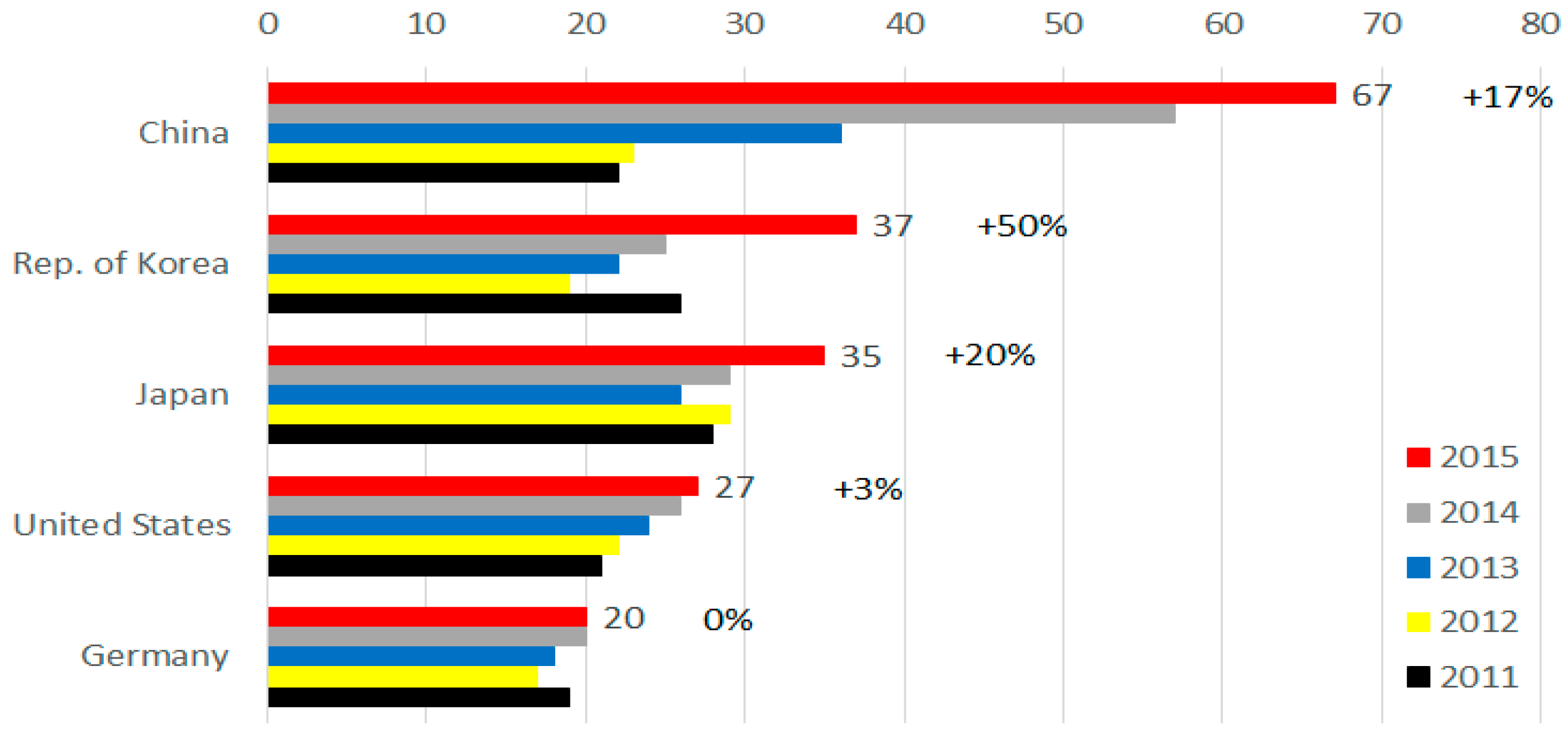
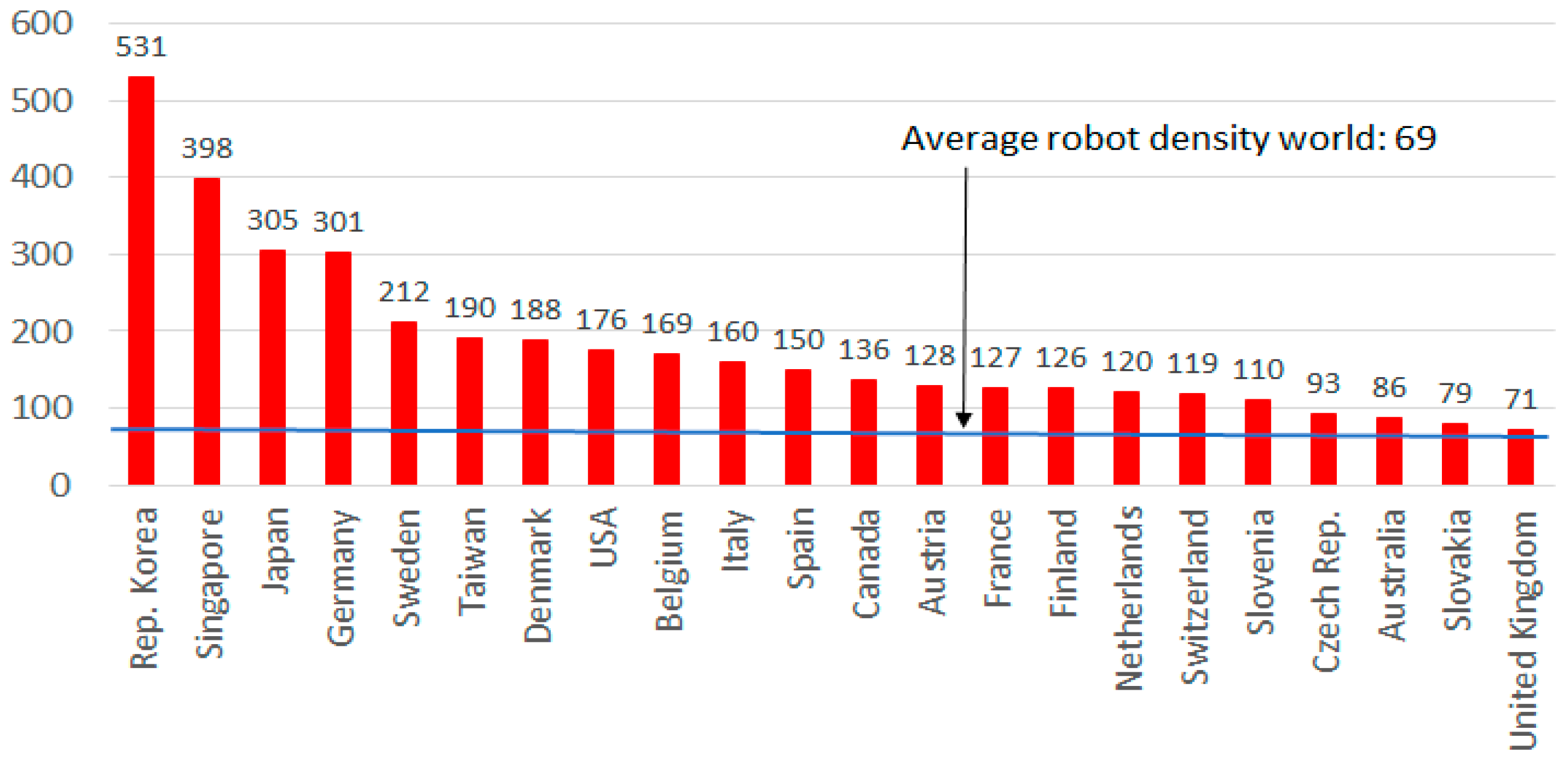
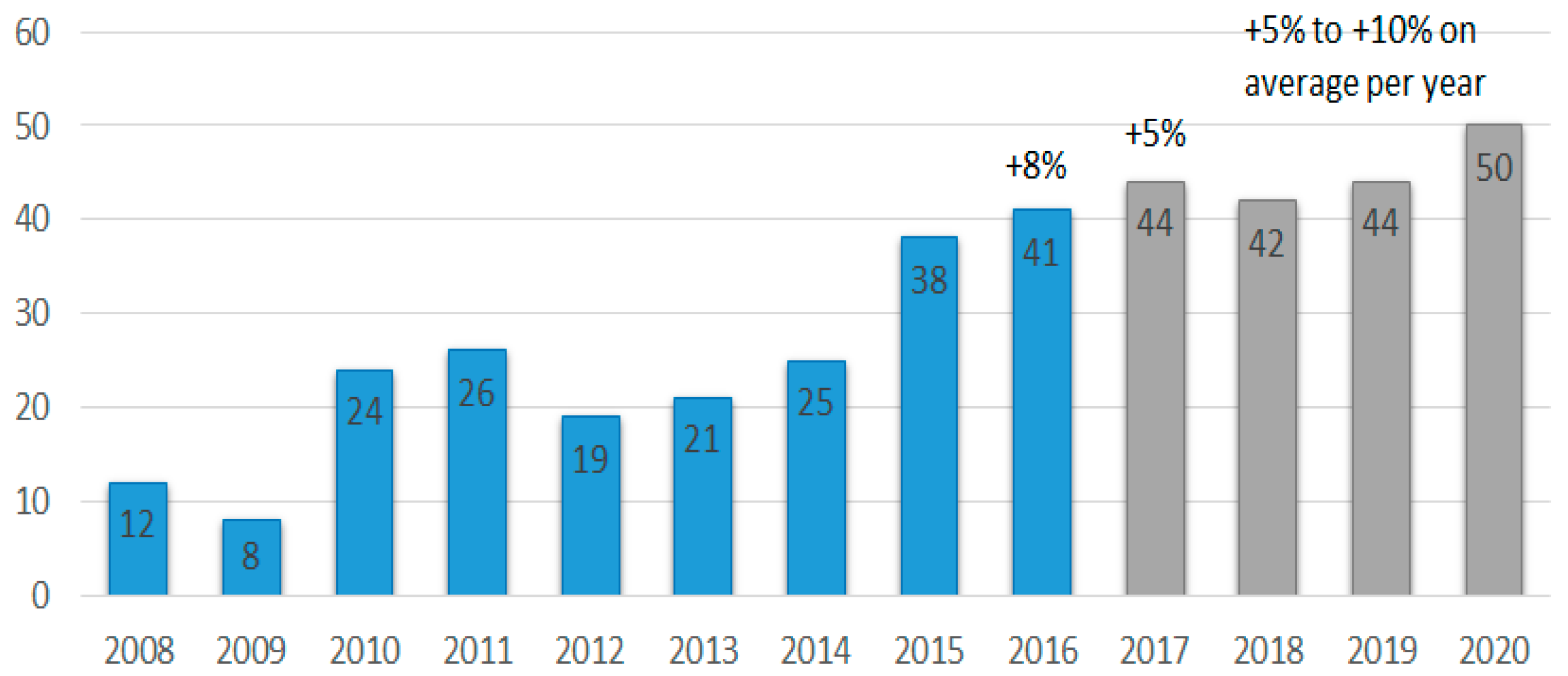
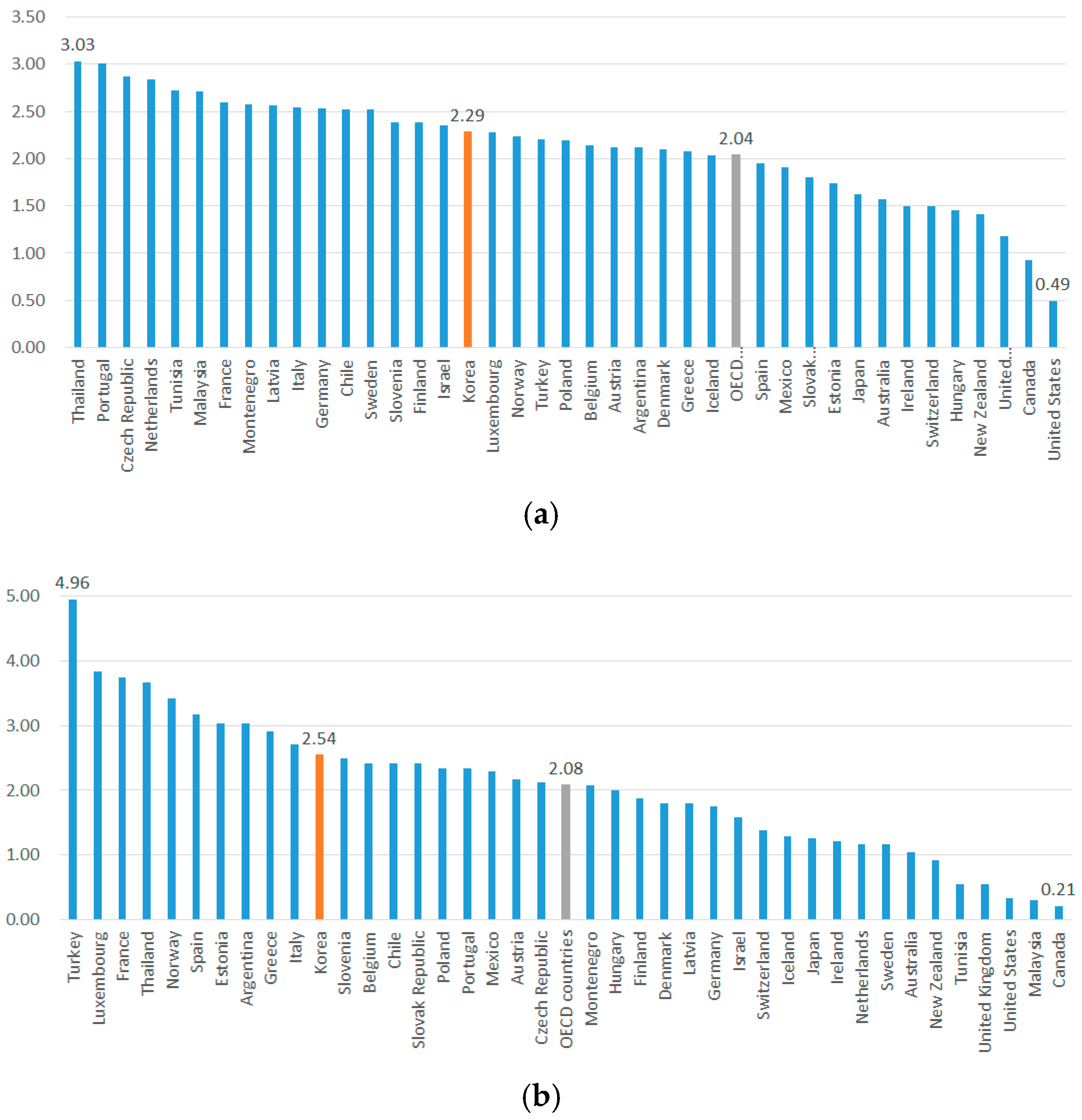
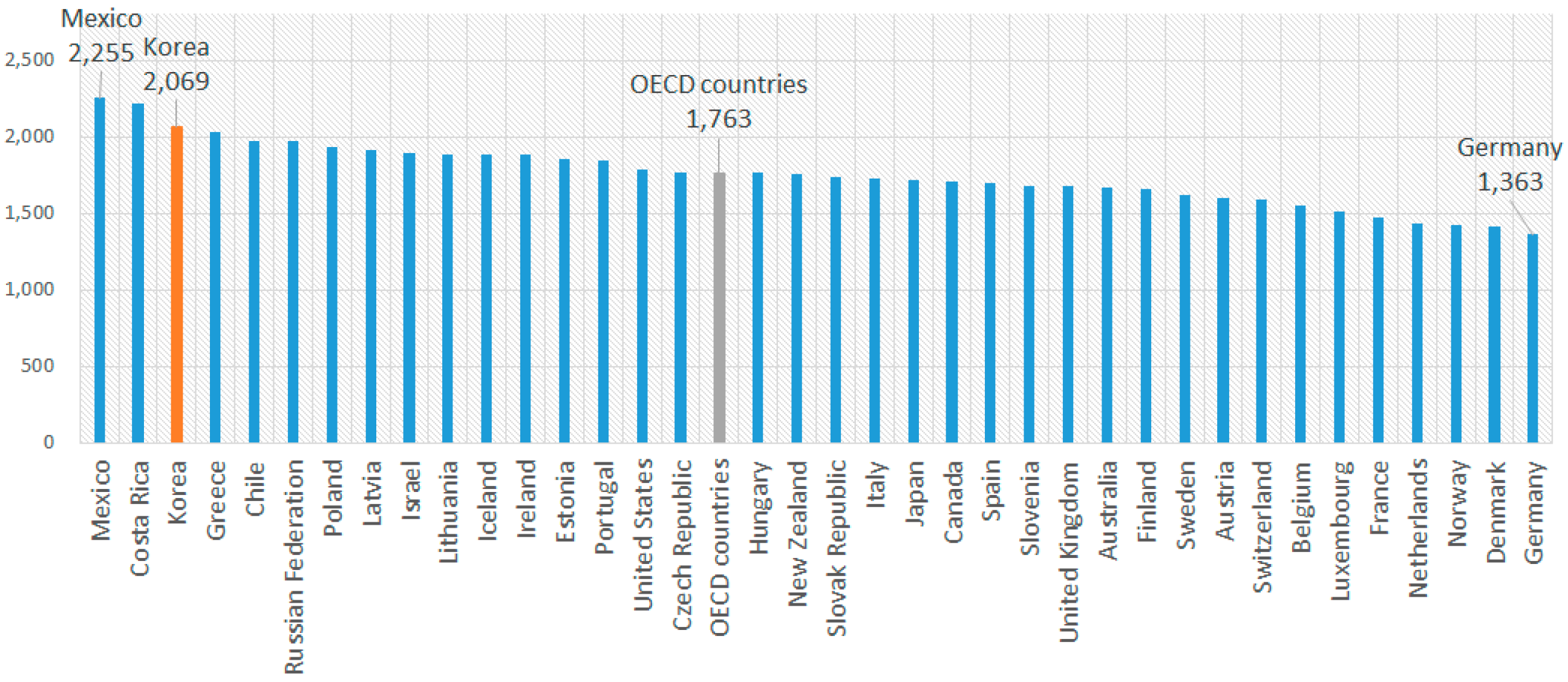
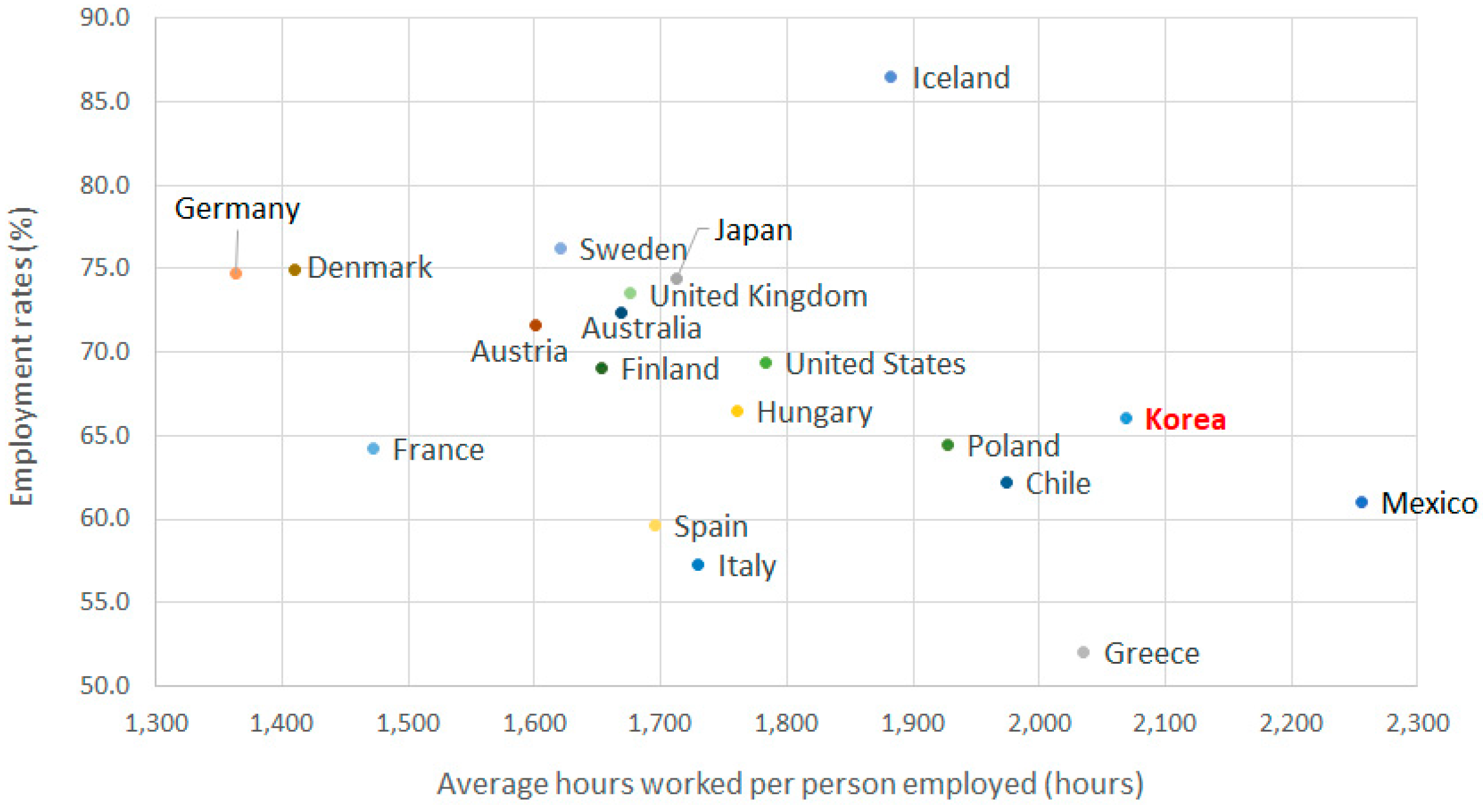
| Industry | No. of Industrial Robots Installed | % of Industrial Robots Installed | ||||
|---|---|---|---|---|---|---|
| 2009 | 2014 | Increase/Decrease | 2009 | 2014 | Increase/Decrease | |
| Manufacturing | 23,813 | 34,870 | 11,057 | 99.99 | 99.91 | −0.08%p |
| 30-Automobile and trailer manufacturing 1 | 12,834 | 22,781 | 9947 | 53.89 | 65.33 | 11.44%p |
| 26-Electronic parts, computers, film, sound and communication system manufacturing 1 | 4778 | 4250 | −528 | 20.06 | 12.19 | −7.88%p |
| Other manufacturing | 6201 | 7839 | 1638 | 26.04 | 22.48 | −3.56%p |
| Non-manufacturing 2 | 3 | 32 | 29 | 0.01 | 0.09 | 0.08%p |
| Total | 23,816 | 34,902 | 11,086 | 100 | 100 | 0.00%p |
| Wage Workers | 1962.7 | (100.0) | Direct Employment | Indirect Employment | |
|---|---|---|---|---|---|
| Non-regular employment | 644.4 | (32.8) | - | - | |
| Atypical | Temporary agency | 20.1 | (1.0) | - | 222.0 (11.3) |
| Contract agency | 69.6 | (3.5) | |||
| Special types | 49.4 | (2.5) | |||
| Home-based | 4.2 | (0.2) | |||
| On-call | 86.3 | (4.4) | |||
| Part-time employment | 248.3 | (12.6) | 1740.6 (88.7) | - | |
| Contingent employment | Fixed-term | 293.0 | (14.9) | ||
| Non-fixed-term | 72.7 | (3.7) | |||
| Regular employment | 1318.3 | (67.2) | |||
| Weekly Working Hours | Average Monthly Wage | Relative Wage Ratio (Regular emp. = 100) | ||
|---|---|---|---|---|
| Wage employment | 40.9 | 236.8 | - | |
| Regular employment | 43.7 | 279.5 | 100.0 | |
| Non-regular employment | 35.2 | 149.4 | 53.5 | |
| Contingent employment | Fixed-term | 36.9 | 165.6 | 59.3 |
| Non-fixed-term | 39.9 | 169.4 | 60.6 | |
| Atypical employment | Temporary agency | 39.1 | 174.5 | 62.4 |
| Contract agency | 43.5 | 146.1 | 52.3 | |
| Special types | 39.3 | 200.0 | 71.6 | |
| Home-based | 30.1 | 77.6 | 27.8 | |
| On-call | 37.7 | 137.5 | 49.2 | |
| Part-time employment | 20.8 | 74.1 | 26.5 | |
| Direct employment | 41.0 | 246.9 | - | |
| Indirect employment | 40.0 | 157.1 | - | |
| Large Corporations (300 Employees or More) | Small and Medium Enterprises (10–299 Employees) | Small Firms (10 or Fewer Employees) | Total | |
|---|---|---|---|---|
| Regular employment | 16.0 | 54.5 | 29.6 | - |
| Non-regular employment | 5.2 | 46.1 | 48.8 | - |
| Union membership among regular employees | 40.6 | 17.0 | 2.6 | 16.5 |
| Union membership among non-regular employees | 8.9 | 4.0 | 0.5 | 2.6 |
| Direct employment | 13.9 | 52.5 | 33.6 | - |
| Indirect employment | 1.1 | 45.5 | 53.4 | - |
| Union membership among direct employees | 36.6 | 14.4 | 2.0 | 13.3 |
| Union membership among indirect employees | 6.8 | 1.8 | 0.4 | 1.1 |
| Variable | N | Means | S.D. | Min | Max |
|---|---|---|---|---|---|
| Log Robotization indicator | 8231 | 6.289 | 3.828 | 2.197 | 10.459 |
| Rate of growth: total employment | 8231 | 0.531 | 2.009 | −0.999 | 8.111 |
| Rate of growth: direct employment | 7788 | 0.373 | 1.802 | −1.000 | 7.000 |
| Log total working hours (month) | 8231 | 5.103 | 0.289 | 2.303 | 5.966 |
| Log total wage (month, 1000 KRW) | 8231 | 7.493 | 0.499 | 4.682 | 9.852 |
| Union membership rate | 8231 | 0.028 | 0.148 | 0.000 | 1.000 |
| Proportion of production workers | 8231 | 0.318 | 0.382 | 0.000 | 1.000 |
| Proportion of simple labor workers | 8231 | 0.100 | 0.238 | 0.000 | 1.000 |
| Company size: 1–4 | 8231 | 0.507 | 0.500 | 0 | 1 |
| Company size: 5–29 | 8231 | 0.393 | 0.488 | 0 | 1 |
| Company size: 30–299 | 8231 | 0.090 | 0.286 | 0 | 1 |
| Company size: 300+ | 8231 | 0.010 | 0.098 | 0 | 1 |
| Manufacturing industry (dummy) | 8231 | 0.545 | 0.498 | 0 | 1 |
| (1) | (2) | (3) | (4) | (5) | (6) | (7) | (8) | (9) | (10) | (11) | |
|---|---|---|---|---|---|---|---|---|---|---|---|
| (1) Rate of growth: t-emp. | 1.000 | ||||||||||
| (2) Log total working hours | 0.070 * | 1.000 | |||||||||
| (3) Log total wage | 0.174 * | 0.537 * | 1.000 | ||||||||
| (4) Union membership rate | 0.104 * | 0.075 * | 0.195 * | 1.000 | |||||||
| (5) Proportion of produc. | 0.058 * | 0.094 * | 0.105 * | 0.143 * | 1.000 | ||||||
| (6) Proportion of simple | −0.005 | −0.056 * | −0.226 * | −0.028 * | −0.193 * | 1.000 | |||||
| (7) Company size: 1–4 | −0.421 * | −0.192 * | −0.377 * | −0.151 * | −0.071 * | 0.064 * | 1.000 | ||||
| (8) Company size: 5–29 | 0.241 * | 0.138 * | 0.264 * | 0.007 | 0.035 * | −0.057 * | −0.819 * | 1.000 | |||
| (9) Company size: 30–299 | 0.290 * | 0.092 * | 0.181 * | 0.216 * | 0.059 * | −0.009 | −0.320 * | −0.257 * | 1.000 | ||
| (10) Company size: 300+ | 0.113 * | 0.024 * | 0.082 * | 0.119 * | 0.020 * | −0.016 * | −0.085 * | −0.069 * | −0.027 * | 1.000 | |
| (11) Manufac. industry | 0.030 * | 0.076 * | 0.106 * | −0.044 * | 0.477 * | −0.067 * | −0.040 * | 0.018 * | 0.027 * | 0.041 * | 1.000 |
| (1) | (2) | (3) | (4) | ||
|---|---|---|---|---|---|
| Total emp. | 0.014 | - | Direct emp. | 0.050 ** | - |
| (0.019) | - | (0.022) | - | ||
| Total emp. × Manufac. | - | 0.439 *** | Direct emp. × Manufac. | - | 0.431 *** |
| - | (0.024) | - | (0.028) | ||
| Log(Total working hrs) | −0.921 *** | −0.985 *** | Log(Total working hrs) | −0.846 *** | −0.946 *** |
| (0.138) | (0.135) | (0.141) | (0.139) | ||
| Log(Total wages) | 1.457 *** | 1.451 *** | Log(Total wages) | 1.419 *** | 1.428 *** |
| (0.088) | (0.086) | (0.090) | (0.088) | ||
| Union membership rate | −2.235 *** | −2.144 *** | Union membership rate | −2.322 *** | −2.215 *** |
| (0.239) | (0.234) | (0.249) | (0.245) | ||
| Proportion of production workers | 5.936 *** | 5.797 *** | Proportion of production workers | 5.942 *** | 5.852 *** |
| (0.091) | (0.090) | (0.093) | (0.092) | ||
| Proportion of simple laborers | 2.409 *** | 2.349 *** | Proportion of simple laborers | 2.353 *** | 2.342 *** |
| (0.149) | (0.146) | (0.151) | (0.148) | ||
| Company size: 5–29 | 0.022 | −0.254 *** | Company size: 5–29 | −0.034 | −0.246 *** |
| (0.081) | (0.077) | (0.083) | (0.079) | ||
| Company size: 30–299 | 0.490 *** | −0.106 | Company size: 30–299 | 0.357 ** | −0.083 |
| (0.139) | (0.132) | (0.145) | (0.138) | ||
| Company size: 300+ | 1.478 *** | 0.379 | Company size: 300+ | 1.168 *** | 0.344 |
| (0.363) | (0.356) | (0.378) | (0.372) | ||
| Constant | −2.063 *** | −1.605 ** | Constant | −2.144 *** | −1.631 ** |
| (0.668) | (0.656) | (0.682) | (0.672) | ||
| Num of obs. | 8231 | 8231 | Num of obs. | 7788 | 7788 |
| F-value | 522.80 | 579.54 | F-value | 499.37 | 575.21 |
| Adj R-squared | 0.363 | 0.388 | Adj R-squared | 0.366 | 0.384 |
© 2018 by the authors. Licensee MDPI, Basel, Switzerland. This article is an open access article distributed under the terms and conditions of the Creative Commons Attribution (CC BY) license (http://creativecommons.org/licenses/by/4.0/).
Share and Cite
Cho, J.; Kim, J. Identifying Factors Reinforcing Robotization: Interactive Forces of Employment, Working Hour and Wage. Sustainability 2018, 10, 490. https://doi.org/10.3390/su10020490
Cho J, Kim J. Identifying Factors Reinforcing Robotization: Interactive Forces of Employment, Working Hour and Wage. Sustainability. 2018; 10(2):490. https://doi.org/10.3390/su10020490
Chicago/Turabian StyleCho, Joonmo, and Jinha Kim. 2018. "Identifying Factors Reinforcing Robotization: Interactive Forces of Employment, Working Hour and Wage" Sustainability 10, no. 2: 490. https://doi.org/10.3390/su10020490
APA StyleCho, J., & Kim, J. (2018). Identifying Factors Reinforcing Robotization: Interactive Forces of Employment, Working Hour and Wage. Sustainability, 10(2), 490. https://doi.org/10.3390/su10020490




